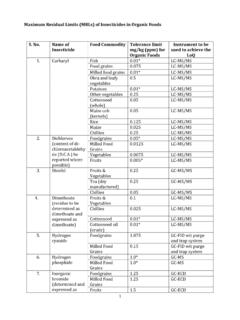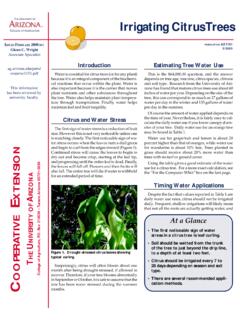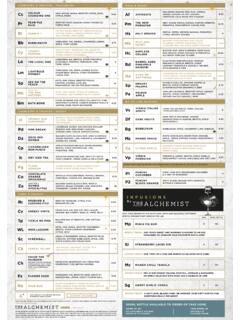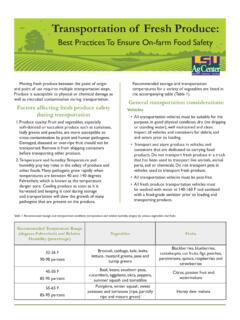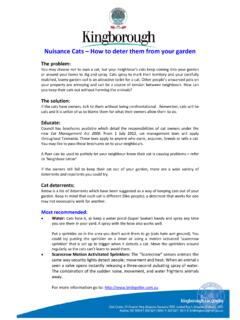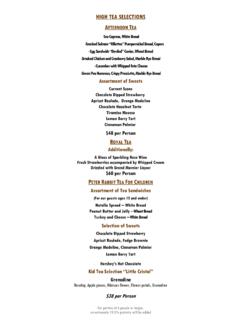Transcription of Citrus Production in California - CDFA
1 Figures 1a and 1b: Area of bearing Citrus trees in California since 1920 [7]. Citrus Production in California Daniel Geisseler and William R. Horwath Background Citrus fruits were introduced in California by the padres around first recorded Citrus orchard was planted in 1804 at the San Gabriel mission, east of Los Angeles. In the early years, Citrus were mainly grown in the missions from San Diego in the south to San Jose in the north and in garden plantings in the Los Angeles area. The first commercial orchard was planted by William Wolfskill in 1841 near what is now the center of downtown Los Angeles [5].
2 Starting in the 1870, the Citrus industry expanded quickly. While it was based on some 90,000 trees in 1875, this number had increased to approximately 2 million trees in 1885 and to million trees in 1901 [5]. The completion of the transcontinental railways greatly promoted this boom. Commercial fruit Production was concentrated in the three Southern Californian counties of Los Angeles, San Bernardino, and San Diego [8]. Plantings of navel oranges, introduced in California by the USDA in 1870, contributed most to the boom. The popularity of the Valencia orange grew slowly at first, but the acreage started to increase rapidly after 1910 [5].
3 The lemon and grapefruit industries developed in the 1890s. The lemon industry benefitted from low orange prices due to overproduction and a freeze in Florida which wiped out the lemon industry there. While in 1882 some 62,000 bearing lemon trees were counted in California , this number had increased to 800,000 trees in 1901 [5]. In the early 20th century, the orange and lemon industries continued to grow. Especially the Production of Valencia oranges increased, surpassing the navel orange acreage by the end of the 1920s (Figure 1). With 148,000 acres of bearing trees, the Valencia orange Production reached a maximum in 1946 [5].
4 The Citrus industry was centered in southern California , where 85% of the state s Citrus fruits were produced [1]. After World War II, Production in southern California rapidly declined due to urbanization and the virus disease tristeza [1, 3]. Within ten years, the total Citrus acreage in California decreased from 330,000 acres to 230,000 acres in 1956 (Figure 1). The need for greater Production was filled with Citrus plantings on the east side of the central and southern San b) a) Citrus Production Page 2 Figure 2: Location of the five leading Citrus producing counties in California [6]. Figure 3: Orange Production in California in percent of Production [6].
5 Joaquin Valley. Most of these plantings were navel oranges. Both orange and lemon industries saw a second boom following these replantings, with Production increasing steadily from the mid 1960s until the mid 1970s. The plantings in the southern and central San Joaquin Valley and to a lesser extent in the low desert area led to a second boom in the orange industry. In the 1970s, Navel oranges once again became the dominant Citrus fruit produced in California (Figure 1) [1]. As of 2012, other Citrus such as kumquats, limes, pummelos and hybrids were grown on a combined total of less than 3000 acres [6]. Today s Production With 260,000 to 270,000 acres, the total acreage of bearing Citrus orchards has changed little since the turn of the century.
6 However, the type of fruits produced has seen some remarkable shifts. The Production of Valencia oranges has decreased, while the acreage of navel oranges has increased. Furthermore, tangerines have recently gained in popularity (Figure 1) [7]. More than half of the bearing acreage now produces navel oranges, while Valencia oranges and lemons are produced on approximately 17% of the Citrus acreage each [7]. Citrus fruit is mainly produced for fresh consumption in California . Thanks to the different climate zones, fresh fruits are harvested most of the year. Valencia oranges are primarily a summer fruit and navels a winter fruit , though the navel and Valencia fresh marketing seasons do overlap some in the spring [2].
7 Close to 90% of California s Citrus acreage is located in the five leading counties, namely Fresno, Kern, Tulare, Ventura and Riverside (Figure 2) [6]. Today, close to 70% of the state s acreage is located in Fresno, Kern and Tulare Counties [6]. Orange County, which had 60,000 acres of oranges in 1950, reported only 71 acres in 2013 [2, 4]. Until the 1930s, roughly 70% of the oranges produced in the originated from California . The market share decreased considerably during the following 30 years (Figure 3). Since then California s market share has fluctuated between 15 and 40%, averaging some 25%. With a market share of close to 75%, Florida is the dominant orange producer in the [6].
8 Citrus Production Page 3 Figure 4: Orange and lemon yields since 1920 in California [7]. Yield Citrus yield has increased considerably over the past 100 years (Figure 4). While approximately 100 boxes were harvested per acre in the early 19th century, the yield has now reached some 300 boxes of oranges and 400 boxes of lemons (Figure 4) [7]. The yield of navel and Valencia may differ considerably for any given year. On average however, the yields are very similar with Valencia oranges being slightly more productive. Fertilization Based on USDA surveys administered every four to six years since 1993, California Citrus growers applied on average 100-110 lbs N/acre to oranges, lemons and grapefruits.
9 During the same period, the applications to tangerines averaged 80 lbs N/acre [6]. The phosphate (P2O5) and potassium (K2O) applications to all Citrus types averaged 42 and 52 lbs/acre, respectively [6]. While 80% of growers reported applying nitrogen, phosphorus and potassium fertilizers were applied on roughly one fourth of the acreage [6]. References 1. Brown, , Platt, , 1983. fruit and nut crops Citrus . In: Scheuring (Ed.) A Guidebook to California Agriculture. University of California Press, Berkeley and Los Angeles. pp. 152-154. 2. Johnston, , 2003. Cross sections of a diverse agriculture. In: Siebert, J.
10 (Ed.) California Agriculture: Dimensions and Issues. Information Series Giannini Foundation of Agricultural Economics, UC Berkeley. pp 29-55. Available online at: (Accessed October, 2014) 3. Johnston, , McCalla, , 2004. Whither California agriculture: Up, down, or out? Some thoughts about the future. Special Report Series, Giannini Foundation of Agricultural Economics, UC Berkeley. Available online at: (Accessed October, 2014) 4. Orange County Agricultural Commissioner, 2014. Orange County Crop Report 2013. Available online at: (Accessed October, 2014) 5. Tufts, , Allen, , Brooks, , Condit, , Cruess, , Davey, , Davis, , Erdman, , Hansen, , Hendrickson, , Hodgson, , Philp, , Shear, , Winkler, , 1946.






